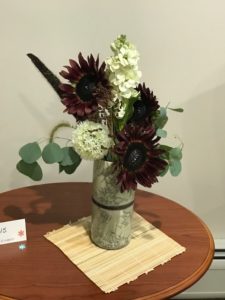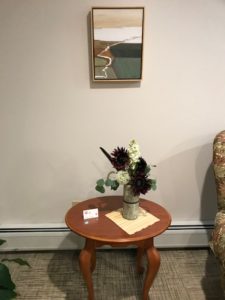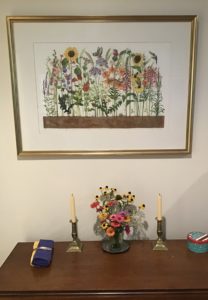October 2020
ART IN BLOOM: This is a call to classmates to send photographs of flower arrangements designed to accompany a painting. Try it—it’s fun!
Sue Bradley Cabot designed this lovely floral arrangement in response to a challenge to create an arrangement to complement a painting in her apartment. Note the Asian theme, highlighted by placing the arrangement on a bamboo mat. I love how the dark maroon dahlias reflect the dark fields or woods of the painting, while the white flowers pick up the stream. Nice job, Sue!
This prompted me (Ann Kingman Williams) to post one of mine. A little history of the painting: it was given to me by the Davidson Garden Club when we left Davidson to move to Maine. It is an original by Robin Wilgus, painted to use as a cover photo for the Davidson Horticultural Symposium XIX ‘Plants in the Company of People’. Very special! I always plant zinnias so I can have table arrangements that complement the painting.
Dana Feldshuh Whyte has written a very poignant and rather hysterical, as well as historical, account of her trials and tribulations of clearing out many years of accumulated ‘everything’ left in the house, basement and ‘shed’ of Curt Smith after his death. It is her hope, and mine, that this will trigger memories and encourage classmates who have been widowed and who had to face similar tasks to share some of their experiences. In Dana’s own words sent to our Scribe Judy Sayler Olmer:
I had written a version of it and sent it to Sheila Porter Lirtzman, who has been quite insistent that I send it to you (Judy Sayler Olmer) because it made her laugh so hard …. perhaps initiating a contest between various class widows of lists of unusual things discovered in the unearthing of their archeological digs in basements, attics, closets and sheds all over the States. (We can assume Europeans have better sense than to save everything.) In any case, many will still have no sense of humor about this prospect, but it has been a year for me now and I find, that, in spite of myself, I am surfacing. I have my moments of chest pain and powerful sense of loss….of structure provided by Curt’s presence since I was 18 years old and a freshman at Mount Holyoke but, my discoveries have amused me.
To begin: Curt’s shed (which would be analogous in importance to my mother’s huge sterling silver tea service which was so important to her but means very little to my way of life (yet I dutifully polish it!)) was originally the old archery shed at Mount Holyoke …. built in the early 1900’s. It was to be demolished when Ham and McGregor were built. Demolish was not a word Curt ever understood, so he obtained permission and flat-bedded it to his property in 1962, dismantling electrical wires on the street as he directed the progress. Over the years he added FIVE appendages (hence, an “atrium”) and the whole of it was densely packed. When he retired, boxes of things followed him into the shed and basement and various closets. The shed is not in good shape but I treat it with respect (like a silver service). The variety of old electronics defies description and there are tools and makeshift tools of every description in addition to newer models of same and a sound system to envy set permanently to NPR. Verdi from the shed was the norm. I perused every box that had not been chewed and nested in and every densely packed box in a basement to die for with 3 well stocked work benches…more old electronics, 20 boxes of photographs plus almost 10 boxes of Charlotte Haywood’s photos…unsorted, scientific and trip related…..and too many boxes of papers inclusive of receipts to the 70’s, bank statements to the 70’s, chapters of books partially written (inclusive of a book on biophysics with a chapter on “information theory” written years before it was widely taught…) and correspondence about possible publication. I read hundreds of fan mail letters from former students, thanking him, missing him, keeping him up to date on their progress (or lack thereof) …. inclusive of my own over decades (my son’s birth announcement was even there) …. There were stashes of letters going back to the 60’s in no order. There was communication between 5 buddies stationed different places during WWII …. five 19 year old’s discussing the “meaning of life” and “Science”. These were from 1944. There was original poetry, the progress/process of writing his published book, ”Ancestral Voices” and responses to it , critical and laudatory and one fan had written a ballad after reading it. There was every “Award” a class may have given him in jest and, of course, a number of retirement notices and commendations and syllabi from courses taught. There was a grade book so old that my name, “Feldshuh” was in it …. There were reading lists from each Interdisciplinary course ….. eulogies given. There were notes from his PhD courses at U Chicago given by Enrico Fermi in 1948 … All these things have gone to the College archives. There were notes about his work on the Manhattan Project and correspondence indicating that he had sent a piece of the first atomic pile (discovered in the shed) to the Fermi Museum in Chicago. I have not even mentioned the programs to events attended documenting every venue from LaScala to Chapin. Yet these were not the things that made Sheila laugh. I have filled 5 dumpsters, taken 1000# scrap metal to recycle, recycled papers and magazines to the 50’s and sent 2 truckloads of old electronics to wherever they go. Mind you, I have more of everything inclusive of more broken glass, damaged screens, kymograph drums, pieces of wire and string and although much has been taken by the family, I have a mound of hammers, a mound of screw drivers, clamps and plyers. One closet filled with “valuable prizes” took 3 steady days of confining work tosort and distribute to a Boy’s and Girl’s Club Carnival. I might also mention the wine cellar with about 200 bottles of wine …. some of which may fit in the category of hazardous waste.
Sheila’s mirth came when I described my contact with Haz Mat. When I collected all the unknown “stuff” in rusted containers and /or unlabeled gallon glass jars, it was clear that I could not safely dispose of it. I had a large room in the basement with cans and bottles covering the floor. After trying to make an appointment to have this evaluated (“Ray” and I became good friends) 2 white suited men finally came and spent TWO days identifying, cataloging and packing it, having brought it to the garage. Then it was two more weeks before a truck came to haul it away and I wrote a check for $4500 ….. (Wasn’t I a responsible citizen?) Included in the mix were a few cans of paint, gallons of lab acids (hydrochloric, sulfuric and hyaluronic), arsenic, cyanide, mercury, barbiturates, something labeled “radioactive” and the usual cleaners and paint thinners, glues and propane. There were also 2 hand grenades and old fireworks. The grenades were not live but we did not know that….and several old batteries ….. anyone wonder why I feared fire/explosion? The guys told me they had never seen such a collection in a private home. This collection is balanced by the art objects (plaster of paris) which were broken when they were being moved to the new Art building but have since been restored and displayed in the house on the walls, standing in corners …. the Rosetta stone used as a table. Again, the Haz Mat men were intrigued. One could imagine Curt coming home from Campus with a statue of Venus slung over his shoulder saying to his deceased wife, “Where do you want this one, Lady Elgin?”
I also want to say that in response to some of the correspondence that I found …. depending on whether the same sender’s name reappeared and /or if the content was any more than a thank you, I emailed the alumnae involved sending them the eulogy and saying that I would elaborate about his final days if they wanted to know. Every one of them wrote back and asked me to and I have made some new friends. A couple have even come to visit. This has been strangely comforting to me and I like to think of Curt bringing alumnae together even in death. Life in South Hadley has been an adventure …. then and now…..and I have not even mentioned the students who continue to bring me joy!
May the Force be with Us…………dana
We are Amazons! Read below to find out just why:
from The Secret History of Wonder Woman by Jill Lepore. In the early-to-mid 1800s, female education in America was still a novelty. But the effort by some women to gain equality soon gained traction, and the women’s suffrage movement began:
“[In the 1800s,] female education was, as yet, a novelty. Until the end of the eighteenth century, girls had not typically been taught even how to write. In the new nation, ideas about educating girls began to change; in a republic, women had to know enough of the world to raise sons who could be virtuous citizens. Mount Holyoke [an all-women’s college and the first of the ‘Seven Sisters’ colleges] was founded in 1837. Plenty of critics were on hand to warn its students not to get carried away with any fancy ideas about equality. On July 4, 1851, during a celebration marking the seventy-fifth anniversary of the Declaration of Independence, C. Hartwell, from a nearby boys’ theological seminary, read to the assembled Mount Holyoke girls a parody he’d written of Elizabeth Cady Stanton’s 1848 ‘Declaration of Sentiments.’ He called it an ‘Amazonian Declaration of Independence.’
” ‘We hold these truths to be intuitive and indisputable, that all men and women are created free and equal,’ Hartwell read aloud, finding that very funny.
“Suffragists, though, didn’t think Amazons were preposterous; they thought they were amazing. From the time of Homer, an Amazon had meant a member of a mythic ancient Greek race of women warriors who lived apart from men. By the end of the nineteenth century, some suffragists, following the work of male anthropologists, had come to believe that a land of Amazons — an ancient matriarchy that predated the rise of patriarchy — had, in fact, once existed. ‘The period of woman’s supremacy lasted through many centuries — undisputed, accepted as natural and proper wherever it existed, and was called the matriarchate, or mother-age,’ Elizabeth Cady Stanton explained in 1891.
“American girls started going to college in significant numbers only at the end of the nineteenth century. Many, like Sadie Holloway, went to women’s colleges, one of the ‘Seven Sisters’ founded before 1889: Mount Holyoke, Barnard, Bryn Mawr, Radcliffe, Smith, Vassar, and Wellesley. Others went to coeducational schools. In 1910, 4 percent of Americans between the ages of eighteen and twenty-one went to college; by 1920, that number had risen to 8 percent, 40 percent of which were women.
“By … 1911, an ‘Amazon’ meant any woman rebel — which, to a lot of people, meant any girl who left home and went to college. ‘New Women,’ they were called, and they meant to be as free as men: Amazons, all.”
Did you know that Emily Dickinson had created a beautiful, and beautifully organized herbarium, which has been digitized so that it can be enjoyed by all? Here is the link, for your enjoyment: https://www.brainpickings.org/2017/05/23/emily-dickinson-herbarium/
https://www.brainpickings.org/2017/05/23/emily-dickinson-herbarium/
With everything that has been going on recently, here and around the world, I thought we needed a lift. I found ‘The Green Thing’ on Face Book (yes, I do enjoy catching up with family and friends who use social media…). It’s not ‘really’ new, but it popped up again recently, and I thought you’d enjoy it. The author is unknown to me. (AKW)
“Our Generation Didn’t Have ‘The Green Thing’”
Checking out at the store, the young cashier suggested to the much older lady that she should bring her own grocery bags, because plastic bags are not good for the environment. The woman apologized to the young girl and explained, “We didn’t have this ‘green thing’ back in my earlier days.”
The young clerk responded, “That’s our problem today. Your generation did not care enough to save our environment for future generations.”
The older lady said that she was right — our generation didn’t have the “green thing” in its day.
The older lady went on to explain:
Back then, we returned milk bottles, soda bottles and beer bottles to the store. The store sent them back to the plant to be washed and sterilized and refilled, so it could use the same bottles over and over. So they really were recycled.
But we didn’t have the “green thing” back in our day.
Grocery stores bagged our groceries in brown paper bags that we reused for numerous things. Most memorable besides household garbage bags was the use of brown paper bags as book covers for our school books. This was to ensure that public property (the books provided for our use by the school) was not defaced by our scribblings. Then we were able to personalize our books on the brown paper bags.
But, too bad we didn’t do the “green thing” back then.
We walked up stairs because we didn’t have an escalator in every store and office building. We walked to the grocery store and didn’t climb into a 300-horsepower machine every time we had to go two blocks.
But she was right. We didn’t have the “green thing” in our day.
Back then we washed the baby’s diapers because we didn’t have the throw away kind. We dried clothes on a line, not in an energy-gobbling machine burning up 220 volts. Wind and solar power really did dry our clothes back in our early days. Kids got hand-me-down clothes from their brothers or sisters, not always brand-new clothing.
But that young lady is right; we didn’t have the “green thing” back in our day.
Back then we had one TV, or radio, in the house — not a TV in every room. And the TV had a small screen the size of a handkerchief (remember them?), not a screen the size of the state of Montana. In the kitchen we blended and stirred by hand because we didn’t have electric machines to do everything for us. When we packaged a fragile item to send in the mail, we used wadded up old newspapers to cushion it, not Styrofoam or plastic bubble wrap. Back then, we didn’t fire up an engine and burn gasoline just to cut the lawn. We used a push mower that ran on human power. We exercised by working so we didn’t need to go to a health club to run on treadmills that operate on electricity.
But she’s right; we didn’t have the “green thing” back then.
We drank from a fountain when we were thirsty instead of using a cup or a plastic bottle every time we had a drink of water. We refilled writing pens with ink instead of buying a new pen, and we replaced the razor blade in a razor instead of throwing away the whole razor just because the blade got dull.
But we didn’t have the “green thing” back then.
Back then, people took the streetcar or a bus and kids rode their bikes to school or walked instead of turning their moms into a 24-hour taxi service in the family’s $45,000 SUV or van, which cost what a whole house did before the “green thing.” We had one electrical outlet in a room, not an entire bank of sockets to power a dozen appliances. And we didn’t need a computerized gadget to receive a signal beamed from satellites 23,000 miles out in space in order to find the nearest burger joint.
But isn’t it sad the current generation laments how wasteful we old folks were just because we didn’t have the “green thing” back then?
And here are a few additions for today:
When Women Were Birds
“Once upon a time, when women were birds, there was the simple understanding that to sing at dawn and to sing at dusk was to heal the world through joy. The birds still remember what we have forgotten, that the world is meant to be celebrated.”
~ Terry Tempest Williams
STORAGE
When I moved from one house to another
there were many things I had no room
for. What does one do? I rented a storage
space. And filled it. Years passed.
Occasionally I went there and looked in,
but nothing happened, not a single
twinge of the heart.
As I grew older the things I cared
about grew fewer, but were more
important. So one day I undid the lock
and called the trash man. He took
everything.
I felt like the little donkey when
his burden is finally lifted. Things!
Burn them, burn them! Make a beautiful
fire! More room in your heart for love,
for the trees! For the birds who own
nothing — the reason they can fly.
~ Mary Oliver



